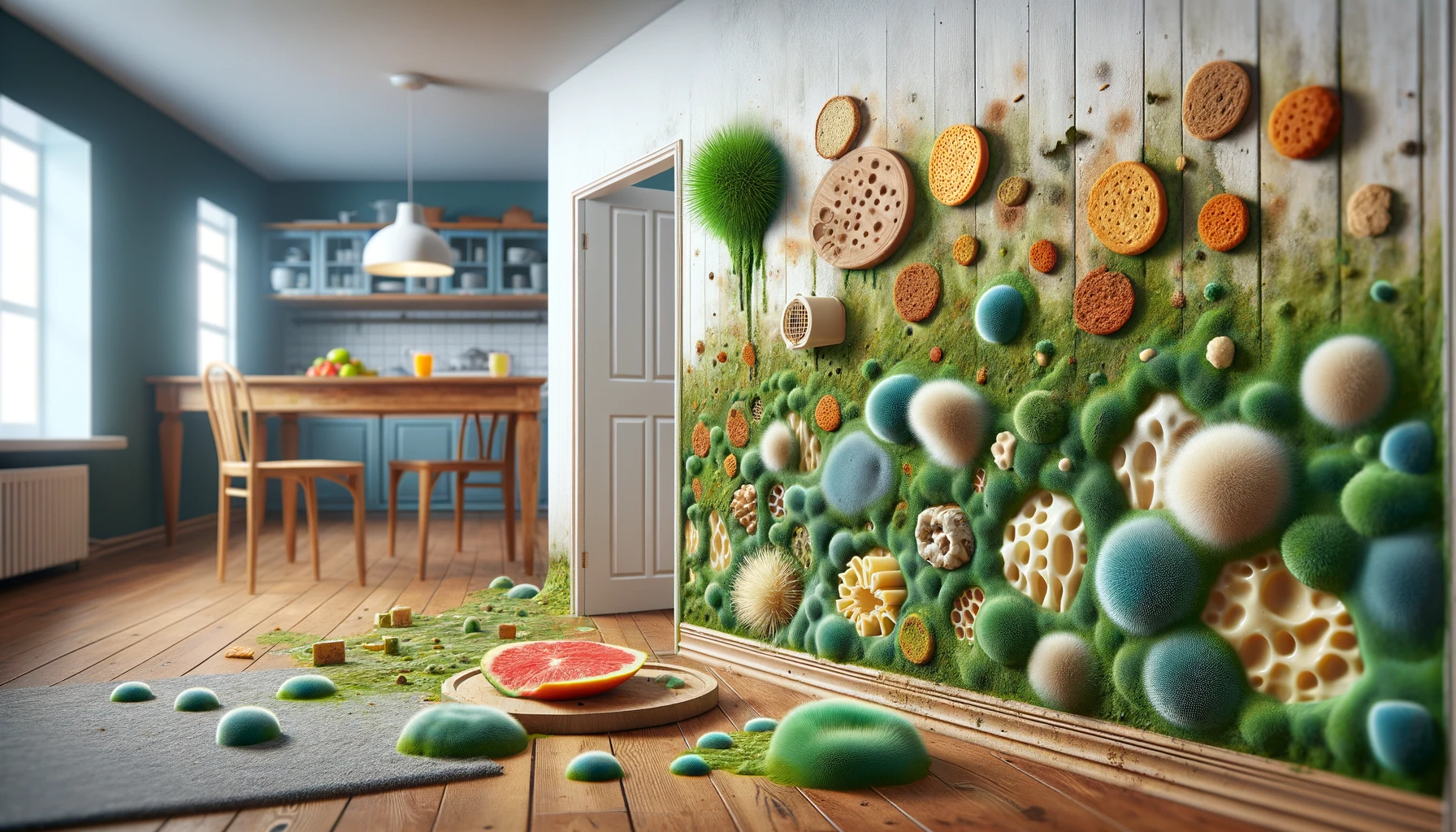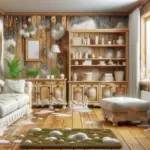[et_pb_section fb_built=”1″ admin_label=”Blog” _builder_version=”4.18.0″ _module_preset=”default” background_color=”#F9F6F5″ custom_padding=”||||false|false” collapsed=”on” global_colors_info=”{}”][et_pb_row _builder_version=”4.20.2″ _module_preset=”default” custom_padding=”||||false|false” global_colors_info=”{}”][et_pb_column type=”4_4″ _builder_version=”4.17.4″ _module_preset=”default” global_colors_info=”{}”][et_pb_text _builder_version=”4.21.0″ _module_preset=”default” header_2_text_color=”gcid-c6518ae1-29db-4f1f-99d4-4111b62b7e61″ hover_enabled=”0″ global_colors_info=”{%22gcid-c6518ae1-29db-4f1f-99d4-4111b62b7e61%22:%91%22header_2_text_color%22%93}” sticky_enabled=”0″]
Green mold is a type of fungus that can affect plants, crops, and other agricultural products. There are several different species of green mold. However, the most common types are Aspergillus, Cladosporium, and Penicillium.
Cladosporium
Is olive green-colored mold and flourishes on plants in particular, but it can also grow on surfaces like walls, cabinets, and carpets.
Aspergillus
Proliferates on food that has gone bad, like bread. Not only can it thrive in nutrient-deficient conditions but also in moist and humid environments like basements.
Penicillium
Of all fungus types, this is the most known for its antibacterial properties and its color is usually blue-ish green. Penicillium can also produce mycotoxins that are hazardous to people and pets alike. It is generally found in colder environments such as soil, however, some can form in moisture-rich environments items within a home.
Green mold can be identified by its soft, fuzzy and powdery appearance that varies in shades of green. This fungus is fond of growing on multiple types of food items as well as other humid places around a household.
Green mold typically occurs when the conditions are right for it to grow, such as during wet and humid weather and in homes that have been exposed to water damage. Ensure the security of your home from flood damage by taking immediate action when it occurs. When mold begins to develop, it is not uncommon for it to take on a greenish hue. Any time you combine moisture, organic material (e.g. wood, paper, food) and warmth, green mold will thrive.
Mold Spores
As mold spores disperse and drift through the atmosphere, they eventually find their way to land on surfaces. These microscopic, single-celled organisms grow and reproduce through tiny threads called hyphae. These hyphae are what allow mold to attach itself to various surfaces, and If the conditions are right, it will grow into colonies. The spores begin generating thread-like cells called hyphae, which absorb nutrients allowing mold to grow. Stachybotrys, commonly known as “black mold,” is usually found in shades of green and black. It happens to be very toxic as it has the most extensive arsenal of weapons because it can produce mycotoxins like no other mold spore.
Mold spores can reproduce very quickly and form dense colonies if they are not removed promptly from the surface where they are growing. To prevent the mold growth of green spores, your home must remain dry and well-ventilated.
Is Green Mold Dangerous?
Although mold may not always be a threat to humans, its mycotoxins can potentially be harmful. So there is a very real potential the species of mold such as green mold can be dangerous.
Mycotoxins are a strategic tool utilized by mold to combat other molds and bacteria.
The degree to which green mold can be dangerous and affect human health is contingent upon the species of the mold (fungus) and the physiological condition of those exposed.
Continuous exposure to green mold causes serious health issues and can be detrimental to your respiratory system, can trigger asthma attacks and aggravate allergies. Depending on the species, mold exposure can have numerous detrimental side effects.
Aspergillus can be the cause of pneumonia and severe lung inflammation. The dangerous strain of Cladosporium has the potential to not only invade skin cells but can even penetrate your brain. Individuals with compromised immune systems, allergies or respiratory issues are particularly susceptible to health problems associated with mold exposure.
Mold can triggers reactions, like coughing, runny nose, watery eyes, and itchy skin, in those susceptible to allergies and asthma. Even individuals with no prior respiratory sensitivities can suffer from allergy-like symptoms when occupying a room overrun by green mold colonies.
Individuals who are particularly vulnerable to the hazards of mold exposure, such as children, elderly persons, cancer patients and those battling other illnesses or infections should take extra precautions against potential health risks.
Preventing Green Mold
To prevent green mold growth, it is important to maintain a dry and well-ventilated environment. Keeping humidity levels below 50% by using dehumidifiers and ventilation fans. Regularly clean surfaces, such as floorboards, windowsills, and ceiling tiles, to remove any mold spores that may have settled. If you have mold in your home, it is important to seek professional help to remove and clean up the affected area.
Consult with a mold removal specialist for more information on effectively managing green mold growth in your home.
It is much better to prevent mold than to deal with a much more massive mold infestation and mold growing.
How to Remove Green Mold?
Given the toxicity of green mold, it is highly advised that you do not attempt to remove it yourself.
Based on the EPA’s (Environmental Protection Agency) recommendations, removing less than 10 square feet of material can be done independently. However, if you are facing mold of any type you should start the mold removal by stopping at the source: moisture.
Repair any plumbing leakage, seal up all crevices in the foundation with caulking, and fill any gaps around windows to keep indoor moisture levels low. Keep your home well-ventilated and dry by removing the source of moisture and food; green mold can be effectively stopped from growing. Wood, drywall, fabric, and other nutrient-rich materials are all staples for this type of fungi, so resolving the humidity, the primary food source, is the key to preventing it from spreading. Note it is highly recommended to call for a professional once continuous exposure can be hazardous.
For small areas and colonies of mold, you can use home remedies like baking soda, vinegar and hydrogen peroxide. To prevent the further spread of spores, be sure to discard all materials related to the removal after completion.
Green mold Test
If you are concerned about the presence of green mold in your house, you may want to consider getting a green mold test. Different types of mold testing are available, so it is important to consult a professional to determine which type is right for you.
Air Sampling
A popular method entails collecting air samples and conducting tests to detect mold spores. This is a quick and non-invasive option, but it may not be able to detect the presence of certain types of green molds that can cause serious health issues.
Surface Sampling
An alternate method involves taking samples from visible areas of mold growth, such as walls, ceilings, and floors. This can be a useful option for detecting the presence of green mold in your home, but it may not accurately assess the extent or severity of a mold problem.
Ultimately, the best way to identify mold problems is to consult with a professional with proper training to recommend a testing method and help you take the necessary steps to safely and effectively remove any green mold.
Green mold is just one species of mold amongst many, but it can cause a massive mold infestation if not taken care of properly. The best way to prevent green mold is through proactive cleaning and maintenance, as this will ensure the well-being of your property and any people or animals that inhabit it.
[/et_pb_text][/et_pb_column][/et_pb_row][/et_pb_section]



